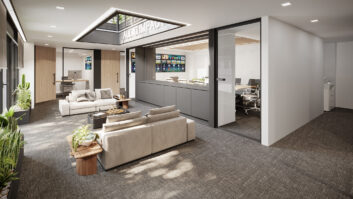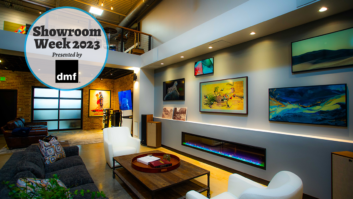Developing a good AV environment is like solving a Rubiks Cube: you must manipulate many factors and satisfy several conditions before the final solution clicks into place. While much thought and effort go into creating a high-quality AV room, establishing the framework for an overall home theater design demands familiarity with the fundamentals: room size, seating layout, and sightlines.
A good starting point in designing a home theater is to arm yourself with a proper set of questions and have a comprehensive debriefing session with the client. Is the client a single person, a couple, or a family with kids? How many people should this theater seat? Does it need to be wheelchair accessible?
Finding out how people will be using the theater can be a complicated process, as tradeoffs will inevitably be involved. You might need to seat 15 people once a year, but what about on a day-to-day basis? Getting great audio coverage over more than just one seat can be tough, and the greater the area, the tougher it gets. The same applies to sightlines.
Room Dimensions
If the home theater is a room that has not been built yet, here is the perfect opportunity to exert some influence on room dimensions. As Floyd Toole, vice president of acoustical engineering at Harman International Industries, points out, what the listener hears at low frequencies is predominantly a function of the room itself. At high frequencies, however, its the loudspeaker that plays the predominant role. Somewhere between these two extremes is a transition region, where a greater impact (loudspeaker or room) gradually shifts as you go up or down in frequency.
The rooms dimensions count because the room will exhibit resonances at particular frequencies, depending on those dimensions. At certain frequencies, sound waves reflecting from a room surface will be in-phase with the sound wave coming directly from the loudspeaker, adding to the sound pressure level. At other frequencies, the reflected sound will be out of phase from the direct sound and cause a cancellation, or near-cancellation, of the direct sound.
Even a loudspeaker with a very smooth frequency response curve will end up with an extremely lumpy response curve in the low-frequency region when that same speaker is placed in a typical listening room. Whats more, the exact frequencies where the peaks and dips occur vary radically with listening locations within the room.
You might think that covering the rooms surfaces with absorptive acoustic material will eliminate the interference between reflected and direct sound. And youd be right, except that: (a) an acoustically dead listening environment is likely to sound strange to most people (were used to reflective spaces), and (b) to be an effective sound-absorber, the material needs to be at least a quarter wavelength in thickness (A quarter-wave at 30 Hz is almost nine and half feet). While acoustically absorbent materials are highly effective at higher frequencies, they wont do much in the bass range without taking up most of the room volume, not to mention budget. Designers sometimes resort to other approaches, such as using bass trapswhich typically take the form of diaphragm-type devices or Helmholtz resonatorsas one way of controlling or minimizing low-frequency room resonances.
Correctly selecting a rooms dimensions, while it wont eliminate room resonances, is another way to minimize the problem. A rooms resonant frequencies (eigenfrequencies) depend on its length, width, and height. If two or more of the rooms dimensions are identical, those resonances will reinforce each other, further exacerbating the problem. A cubic room, for example, where height, width, and length are all the same, would theoretically be a worst-case scenario.
Also avoid having any one dimension be an integral multiple of anothera 10×20-foot room, for example. One rule of thumb is that no dimension should be within five percent of another dimension or a multiple of another dimension. When room dimensions are well chosen, resonances stagger in frequency, rather than having many fall at the same frequency.
Stuck with an existing room? Dont fret too much. Research conducted by Harman International shows that strategic placement of multiple subwoofers in combination with judicious equalization takes care of the worst of the room resonances for most rooms. In its published white papers the company noted that using multiple subwoofers can help achieve more uniform low-frequency response through a large portion of the listening room, with two subwoofers making marked improvement and four subwoofers producing even better results. The most spatially uniform bass was achieved with the subwoofers placed at the midpoints of each of the four walls. In all cases, the subwoofers operated in-phase with each other.
All of this is predicated on rooms being simple rectanglesno L-shaped or other irregularly shaped rooms. Toole notes that Harman has done work in applying multiple subwoofers to more-complex rooms, but the best arrangements simply cant be worked out on paper. Its a combination of multiple subwoofers, but with some signal-processing added, Toole said. For this you need to make some measurements in the roomfrom the subwoofers to the listening area. Theres a little optimization ritual that the [signal processing] device goes through, and it will alter the signals being fed to each of the two, three, or four subwoofers that youve chosen to use. The optimization algorithm aims to minimize the seat-to-seat variation in the bass.
Seating
Seating for the home theater can range from fixed seats, to rockers, to recliners, to incliners.
One of the first things to think about is the comfort level and construction of the chair, said John Dahl, senior fellow and director of education for THX Ltd. People tend to overlook the fact that the seating needs to be good for the long haul. [It] needs to give you good support, fits or can adjust to your particular anatomy, and will let you comfortably sit for several hours.
Recliners typically come with high backs to support the occupants head, but Dahl notes that this interrupts the sound path from 5.1- and 7.1-surround system speakers to the listeners ears. Ideally, the front three speakers should be place at the listeners ear level, but if high-back seats are used the argument can be made for placing surround speakers higher than that.
Seating Location and Sightlines
Depending on if you are working with an existing room size or a screen that has already been chosen, seat placement can be a juggling act. For seat-to-screen distance when using a 1080p display, Dahl recommends that the screen be at a 40-degree horizontal viewing angle, which is achieved when the horizontal image width is 0.73 times the viewing distance. For example, if the size of the room dictates where the seating needs to be, and if thats a viewing distance of eight feet (96 inches), then the screen width should be 70 inches (96 x 0.73).
Conversely, if you are working with a specific display size and want to know what the viewing distance should be, you should divide the screen width by 0.73. For example, if you have a 60-inch diagonal 1080p plasma display with a horizontal picture width of 52.3 inches, a viewing distance of 71.6 inches (about six feet) would give a 40-degree angle of view.
In situations where viewers would like to choose their own seating distance, place a row at the requisite distance for a 40-degree angle of view, with one or more rows behind it for those who prefer sitting further back, and a row up front for kids who often like sitting in the front row. Consult the seating manufacturers specifications for spacing between rows. If using recliners, dont forget to allow enough space to recline.
To give everyone good sightlines, seating rows need to be placed on risers or built on a sloped floor. It is important, therefore, to check into applicable building codes for steps and handrails. If placing multi-level seating, then entrances and exits will need to align with floor levels for the rest of the home. In commercial theaters, the rise between rows can be as much as 18 to 20 inches (for seats up in the mezzanine). For those building home theaters, consider using standard stair-step height for the rise between rows, if possible, which is typically in the range of six to eight feet, seven feet being the average.
If using front projection with a high-gain screen to deal with high ambient light levels, also be sure that those seated on the far left and far right will get reasonable picture brightness. So-called high-gain screens reflect most of the light from the projector straight back on-axis. The screens manufacturer can supply field-of-view specifications. To avoid problems, THX recommends that non-gain screens be used for home theaters, unless ambient light cannot be effectively controlled.
If using front projection, ensure clear sightlines for the projector, as you dont want the audience silhouetted on screen. The more rows of seating that you have, and the greater the rise between rows, the higher the projector or the screen has to be. Trouble can arise with large screens, many rows, and low ceilings, so plan carefully. If ceiling height is not a constraint, this puzzle is much simpler.
In many multipurpose rooms, people often opt to put a plasma screen above a fireplace mantle. To avoid neck strain or uncomfortable seating positions, viewers should not have to look up more than 15 degrees from their viewing position. Screens mounted high can certainly improve sightlines, but unless viewers have high-backed recliners (with their attendant acoustical drawbacks), it can make for bad ergonomics.
Loudspeaker Placement
When considering sightlines think about the loudspeakers as well. Loudspeaker placement guidelines require that there be a clear, unobstructed direct line-of-sight path between each loudspeaker and listening position. A mistake made in many home theater designs is to mount the center-channel speaker below a plasma display. Usually, this places the center-channel so low that those sitting in the front row block the direct path of the speakers high-frequency driver. In multipurpose rooms, a coffee table is sometimes the offending element. It is better to place the center-channel speaker above the screen, even though this may place it close to the ceiling where ceiling reflections can become a problem. Placing acoustically absorbent material in the areas where reflections are likely to occur can bring this under control.
There also should be good acoustical sightlines to the surround speakers, but being primarily concerned with delivering room ambiance rather than primary movie content, clear sightlines will be less critical than for the left-, center-, and right-front speakers. None of the surround speakers should blast directly into anyones ear, as listeners should ideally not be aware of the surrounds as sound sources. This is one reason why surrounds are typically mounted higher than ear-level.
The considerations discussed here are by no means the sum total of what goes into an inspired AV environment, but rather represent a few of the fundamentals that make for a great viewing and listening space. By keeping these points in mind at the start of your design project, youll start on the right foot, and avoid some potential disappointments down the road.
A former loudspeaker designer, Alan R. Frank ([email protected]) is a networking consultant and freelance writer.







